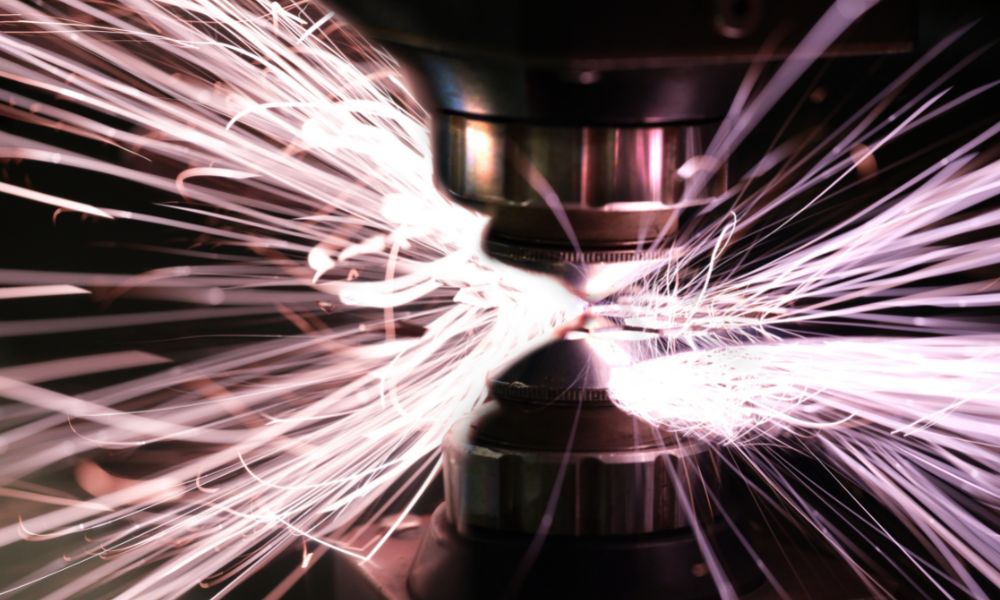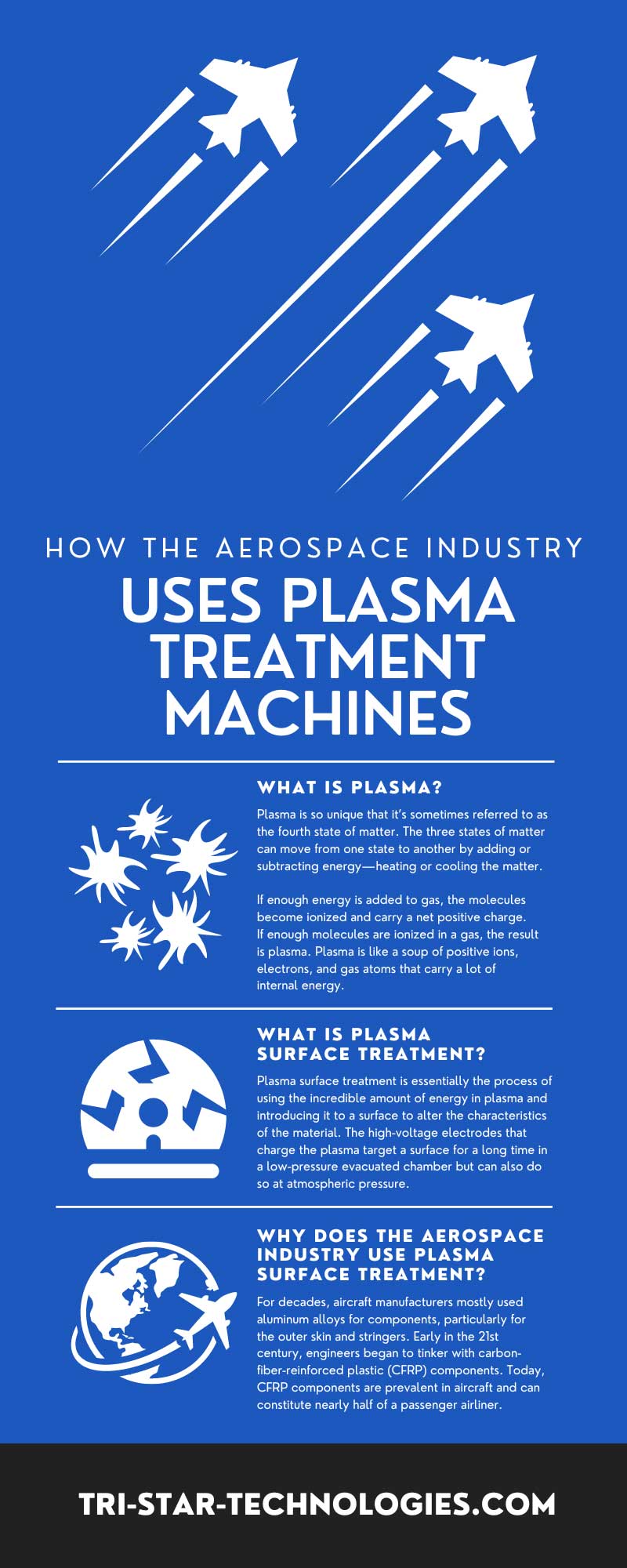How the Aerospace Industry Uses Plasma Treatment Machines

Plasma surface treatment is common in many industries, especially in aerospace. If you’re interested in learning more about the relationship between aerospace and plasma surface treatment and bonding, you’ve come to the right place. Our guide below will explain the basics of plasma, plasma surface treatment, and how the aerospace industry uses plasma treatment machines.
What Is Plasma?
Before examining the applications of plasma treatment machines in aerospace, it’s wise to go over the basics of plasma and plasma surface treatment. Plasma is so unique that it’s sometimes referred to as the fourth state of matter. The three states of matter can move from one state to another by adding or subtracting energy—heating or cooling the matter.
If enough energy is added to gas, the molecules become ionized and carry a net positive charge. If enough molecules are ionized in a gas, the result is plasma. Plasma is like a soup of positive ions, electrons, and gas atoms that carry a lot of internal energy.
What Is Plasma Surface Treatment?
Plasma surface treatment is essentially the process of using the incredible amount of energy in plasma and introducing it to a surface to alter the characteristics of the material. The high-voltage electrodes that charge the plasma target a surface for a long time in a low-pressure evacuated chamber but can also do so at atmospheric pressure.
The ionized air stream of plasma reacts with the material’s surface, breaks the hydrogen bonds, and alters the material’s properties. Ultimately, plasma surface treatment cleans the material’s surface and improves its adhesive characteristics.
What Are the Advantages of Plasma Surface Treatment?
Many industries use plasma surface treatment for many applications, but what are the advantages of the process? The main benefits of using a plasma surface treatment system are it improves the adhesions of the material, applies to many materials, is versatile in its use, and is cost-efficient.
Improves Adhesion
One of the most common issues in manufacturing, whether in aerospace or any other industry, is the bonding of materials—particularly plastics. Many plastic and polymer surfaces are not conducive to bonding, and the only way to bond these lightweight materials is through a long process of using force and heat.
Plasma surface treatment improves the adhesion of plastics and other difficult-to-bond materials on a molecular level. This molecular change makes the materials more ready to bond with adhesives and other media like ink or paint.
Applicable to Various Materials
Another reason that plasma surface treatment is so useful is that it can improve the adhesion of so many materials. Plastic-to-plastic, plastic-to-metal, and plastic-to-composite bonding is difficult because, as mentioned, plastics possess low surface energy and wettability.
But because plasma surface treatment is noninvasive and doesn’t involve heat, it applies to practically any material to improve bonding, including the following:
- Plastics
- Rubbers
- Engineering polymers
- Composites
- Glass
- Metals
- Alloys
- Ceramics
Versatile
One of the reasons that plasma surface treatment is so versatile is that it’s nondestructive. Other methods may require excessive heat or sanding to prepare the surface for bonding.
But plasma surface treatment is noninvasive and doesn’t require heat, so the surface remains intact and still viable for painting, coating, and printing plastic products. The nondestructive nature of plasma surface treatment makes it extremely versatile.
Cost-Efficient
Plasma surface treatment also makes the surface cleaning and bonding process much more productive and cost-efficient for manufacturers, particularly in aerospace. With plasma surface treatment, the bonding process is much easier and quicker, as it cleans surfaces faster and reduces bonding time significantly.
And the process alters the surface of the materials for better bonding, then less ink, coating, paint, and glue is necessary to create strong and stable cohesion. Since manufacturers can use fewer materials, they produce less waste and scraps, creating a more productive and cost-efficient process.
Why Does the Aerospace Industry Use Plasma Surface Treatment?
Now that you understand what plasma surface treatment machines do, we can explain how the aerospace industry uses them. The primary application for plasma surface treatment in the aerospace industry is to prepare composite components for adhesive bonding.
For decades, aircraft manufacturers mostly used aluminum alloys for components, particularly for the outer skin and stringers. Early in the 21st century, engineers began to tinker with carbon-fiber-reinforced plastic (CFRP) components. Today, CFRP components are prevalent in aircraft and can constitute nearly half of a passenger airliner.
What Are CFRP Components in Aerospace?
Plasma surface treatment is particularly common with CFRP components in the aerospace industry, but what are these components, and why is plasma surface treatment so useful for them? A CFRP is a composite material that consists of a matrix (plastic) and a carbon fiber reinforcement.
CFRP components have many advantages, particularly for aerospace manufacturers, because they’re lightweight, strong, and stiff materials thanks to carbon fiber reinforcement. CFRP components also have high chemical and corrosion resistance and are exceptionally durable, making them ideal materials for constructing aircraft.
CFRP Components and Plasma Surface Treatment in Aerospace
Plasma surface treatment helps the aerospace industry unlock the full potential of CFRP components to create lighter and more affordable aircraft more quickly. While CFRP components offer many advantages to aerospace engineers, since they’re a composite material, they require an additional adhesive bonding to combine with other composites, plastic, and metal materials. But mechanical fastening can damage and weaken the CFRP components, so it’s not a useful bonding technique for aircraft.
Enter plasma surface treatment, which cleans and prepares the surface of CFRP components for adhesive bonding and creates high-strength bonds with other plastic, composite, and metal materials. Unlike other cleaning and adhesion processes requiring sanding or heat, plasma surface treatment doesn’t alter the material’s structure or contaminate components. Together, CFRP components and plasma surface treatment are ideal for constructing lightweight but high-strength aircraft for the aerospace industry.
Conclusion
We hope our guide on plasma surface treatment and the aerospace industry has been useful and informative. If you have further questions about plasma surface treatment machines or their applications, contact our expert staff at Tri-Star Technologies. We’re here to help!



